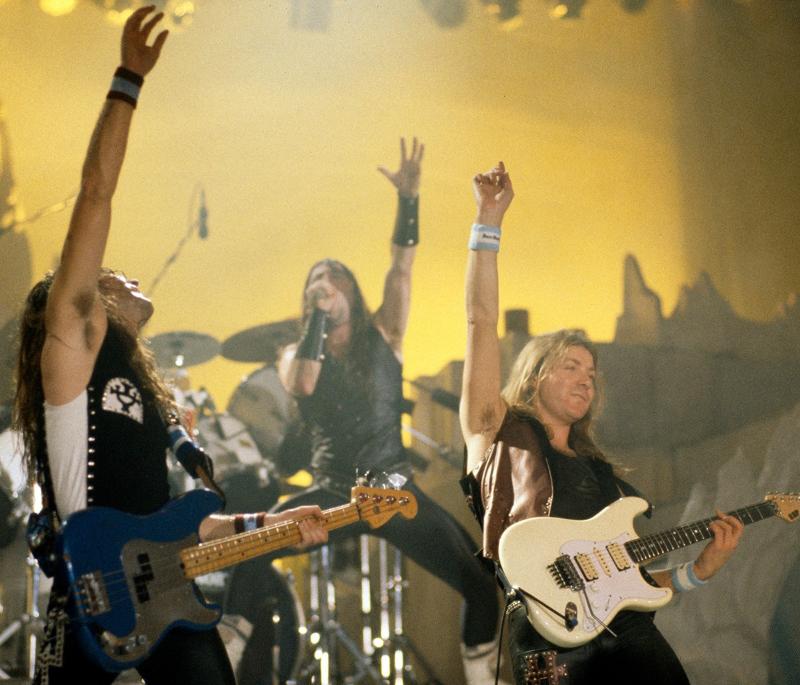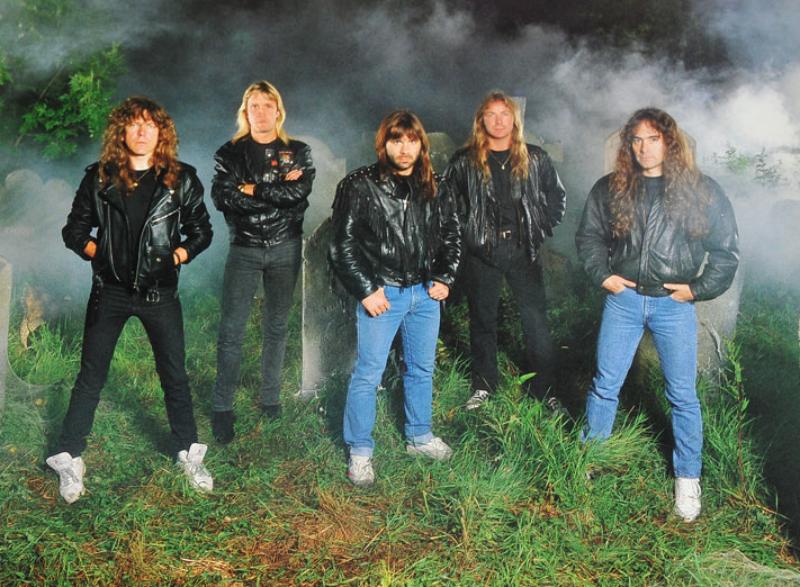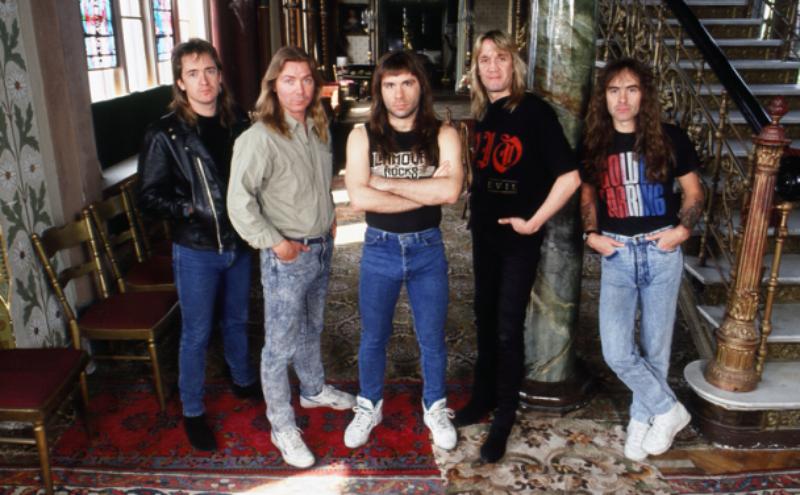News
Iron Maiden’s Evolution in the 90s A New Era
Iron Maiden, one of the most iconic and influential heavy metal bands of all time, has had a long and storied career spanning over four decades. And while their early years in the 80s are often considered their golden era, the 90s marked a significant shift in the band’s sound and lineup. With the departure of lead singer Bruce Dickinson and the arrival of Blaze Bayley, Iron Maiden faced both controversy and critical acclaim in the 90s. In this blog post, we will explore the evolution of Iron Maiden in the 90s, from the controversial Blaze Bayley era to their triumphant reunion with Bruce Dickinson.

The Blaze Bayley Era: A Controversial Chapter
In 1993, after the release of their album “Fear of the Dark,” lead singer Bruce Dickinson announced his departure from Iron Maiden to pursue a solo career. This news came as a shock to fans and left the future of the band uncertain. However, Iron Maiden wasted no time in finding a replacement for Dickinson, and in 1994, they released their first album with new lead singer Blaze Bayley, titled “The X Factor.”
The Arrival of Blaze Bayley
Blaze Bayley, formerly of the band Wolfsbane, was chosen as the new lead singer of Iron Maiden after a lengthy audition process. His powerful vocals and stage presence made him a suitable candidate to fill the shoes of Bruce Dickinson. However, many fans were skeptical about this change, and some even saw it as a downgrade for the band.

The Reception of “The X Factor”
“The X Factor” was met with mixed reviews from both fans and critics. While some praised Bayley’s vocals and the band’s experimentation with a darker and heavier sound, others criticized the album for lacking the energy and catchiness of previous Iron Maiden albums. The album also faced backlash for its lack of iconic Iron Maiden elements, such as the absence of Eddie on the cover art.
Tracklist:
| No. | Title | Length |
|---|---|---|
| 1. | “Sign of the Cross” | 11:17 |
| 2. | “Lord of the Flies” | 5:03 |
| 3. | “Man on the Edge” | 4:13 |
| 4. | “Fortunes of War” | 7:24 |
| 5. | “Look for the Truth” | 5:10 |
| 6. | “The Aftermath” | 6:20 |
| 7. | “Judgement of Heaven” | 5:12 |
| 8. | “Blood on the World’s Hands” | 5:58 |
| 9. | “The Edge of Darkness” | 6:39 |
| 10. | “2 A.M.” | 5:37 |
| 11. | “The Unbeliever” | 8:10 |
The Legacy of “The X Factor”
Despite the mixed reception, “The X Factor” was a commercial success, reaching number one in several countries and selling over a million copies worldwide. It also marked a significant shift in Iron Maiden’s sound, with darker and more introspective themes explored in the lyrics. However, the Blaze Bayley era would be short-lived, as the band faced further challenges in the late 90s.
Fear of the Dark: Exploring the Album’s Themes
Released in 1992, “Fear of the Dark” was Iron Maiden’s last album with Bruce Dickinson before his departure. It is often considered one of their most underrated albums, but it holds a special place in the hearts of many fans. The album’s title track, in particular, has become a staple in Iron Maiden’s live performances.
The Themes of “Fear of the Dark”
“Fear of the Dark” explores themes of fear, loneliness, and the unknown. The title track, written by Steve Harris, is about the fear of the dark that many people experience, whether it be as children or adults. Other tracks on the album, such as “Afraid to Shoot Strangers” and “Childhood’s End,” also touch upon these themes.

The Live After Death Legacy
In 1993, Iron Maiden released their first live album, “Live After Death,” which documented their “World Slavery Tour” from 1984-1985. This album not only captured the energy and power of Iron Maiden’s live performances but also solidified their status as one of the greatest live bands in the world. It also served as a tribute to the Bruce Dickinson era of the band, which would come to an end soon after its release.
Tracklist:
| No. | Title | Length |
|---|---|---|
| 1. | “Intro: Churchill’s Speech” | 0:49 |
| 2. | “Aces High” | 4:56 |
| 3. | “2 Minutes to Midnight” | 6:05 |
| 4. | “The Trooper” | 4:07 |
| 5. | “Revelations” | 6:28 |
| 6. | “Flight of Icarus” | 3:21 |
| 7. | “Rime of the Ancient Mariner” | 13:03 |
| 8. | “Powerslave” | 7:28 |
| 9. | “The Number of the Beast” | 4:50 |
| 10. | “Hallowed Be Thy Name” | 7:17 |
| 11. | “Iron Maiden” | 4:21 |
| 12. | “Run to the Hills” | 3:58 |
| 13. | “Running Free” | 8:43 |
| 14. | “Sanctuary” | 5:16 |
The Legacy of Live After Death
“Live After Death” is often regarded as one of the greatest live albums of all time and has been praised for its production quality and tracklist selection. It also served as a reminder of the legacy of Bruce Dickinson in Iron Maiden and the impact he had on the band’s live performances.
The X Factor: A Return to Heavier Roots
After the release of “The X Factor,” Iron Maiden faced another challenge when Blaze Bayley left the band in 1999 due to creative differences. This marked the return of Bruce Dickinson and guitarist Adrian Smith, who had left the band in 1990. With their reunion, Iron Maiden released their tenth studio album, “Brave New World,” in 2000.
The Themes of “Brave New World”
“Brave New World” explores themes of dystopia, technology, and the human condition. The title track, written by Steve Harris, is inspired by Aldous Huxley’s novel of the same name and reflects on the dangers of a society controlled by technology. Other tracks on the album, such as “The Wicker Man” and “Blood Brothers,” also touch upon these themes.
The Reunion of Bruce Dickinson and Adrian Smith
The reunion of Bruce Dickinson and Adrian Smith was met with great excitement from fans, and “Brave New World” did not disappoint. The album received critical acclaim and was a commercial success, reaching number one in several countries. It also marked a return to Iron Maiden’s classic sound, with the incorporation of Smith’s guitar playing and Dickinson’s powerful vocals.
Tracklist:
| No. | Title | Length |
|---|---|---|
| 1. | “The Wicker Man” | 4:35 |
| 2. | “Ghost of the Navigator” | 6:50 |
| 3. | “Brave New World” | 6:18 |
| 4. | “Blood Brothers” | 7:14 |
| 5. | “The Mercenary” | 4:42 |
| 6. | “Dream of Mirrors” | 9:21 |
| 7. | “The Fallen Angel” | 4:00 |
| 8. | “The Nomad” | 9:06 |
| 9. | “Out of the Silent Planet” | 6:25 |
| 10. | “The Thin Line Between Love and Hate” | 8:27 |
The Legacy of “Brave New World”
“Brave New World” is often considered a comeback album for Iron Maiden, solidifying their status as one of the greatest heavy metal bands of all time. It also marked the beginning of a new era for the band, with the return of Bruce Dickinson and Adrian Smith bringing a renewed energy and creativity to their music.
Virtual XI: Experimentation and Criticism
Following the success of “Brave New World,” Iron Maiden released their eleventh studio album, “Virtual XI,” in 1998. This album saw the departure of guitarist Janick Gers and the addition of new guitarist, Dave Murray’s son, Alex Dickson. It also marked a significant shift in the band’s sound, with the incorporation of more experimental elements.
The Themes of “Virtual XI”
“Virtual XI” explores themes of technology, spirituality, and the human condition. The title track, written by Steve Harris, is about the dangers of becoming too reliant on technology and losing touch with reality. Other tracks on the album, such as “The Angel and the Gambler” and “Futureal,” also touch upon these themes.
The Reception of “Virtual XI”
“Virtual XI” received mixed reviews from both fans and critics. While some praised the band’s experimentation and incorporation of new elements, others criticized the album for lacking the energy and catchiness of previous Iron Maiden albums. It also faced backlash for its lack of cohesion and direction.
Tracklist:
| No. | Title | Length |
|---|---|---|
| 1. | “Futureal” | 2:56 |
| 2. | “The Angel and the Gambler” | 9:52 |
| 3. | “Lightning Strikes Twice” | 4:50 |
| 4. | “The Clansman” | 8:59 |
| 5. | “When Two Worlds Collide” | 6:17 |
| 6. | “The Educated Fool” | 6:44 |
| 7. | “Don’t Look to the Eyes of a Stranger” | 8:03 |
| 8. | “Como Estais Amigos” | 5:30 |
The Legacy of “Virtual XI”
Despite the mixed reception, “Virtual XI” was a commercial success, reaching number one in several countries. It also marked a significant shift in Iron Maiden’s sound, with the incorporation of more experimental elements. However, it would be their last album with Blaze Bayley, as the band faced further changes in the early 2000s.
Brave New World: A Triumphant Reunion
In 1999, after the release of “Virtual XI,” Blaze Bayley left Iron Maiden, and the band faced another challenge in finding a new lead singer. However, they did not have to look far, as Bruce Dickinson and Adrian Smith returned to the band, along with guitarist Janick Gers. With their reunion, Iron Maiden released their twelfth studio album, “Brave New World,” in 2000.
The Themes of “Brave New World”
“Brave New World” explores themes of dystopia, technology, and the human condition. The title track, written by Steve Harris, is inspired by Aldous Huxley’s novel of the same name and reflects on the dangers of a society controlled by technology. Other tracks on the album, such as “The Wicker Man” and “Blood Brothers,” also touch upon these themes.
The Reunion of Bruce Dickinson and Adrian Smith
The reunion of Bruce Dickinson and Adrian Smith was met with great excitement from fans, and “Brave New World” did not disappoint. The album received critical acclaim and was a commercial success, reaching number one in several countries. It also marked a return to Iron Maiden’s classic sound, with the incorporation of Smith’s guitar playing and Dickinson’s powerful vocals.
Tracklist:
| No. | Title | Length |
|---|---|---|
| 1. | “The Wicker Man” | 4:35 |
| 2. | “Ghost of the Navigator” | 6:50 |
| 3. | “Brave New World” | 6:18 |
| 4. | “Blood Brothers” | 7:14 |
| 5. | “The Mercenary” | 4:42 |
| 6. | “Dream of Mirrors” | 9:21 |
| 7. | “The Fallen Angel” | 4:00 |
| 8. | “The Nomad” | 9:06 |
| 9. | “Out of the Silent Planet” | 6:25 |
| 10. | “The Thin Line Between Love and Hate” | 8:27 |
The Legacy of “Brave New World”
“Brave New World” is often considered a comeback album for Iron Maiden, solidifying their status as one of the greatest heavy metal bands of all time. It also marked the beginning of a new era for the band, with the return of Bruce Dickinson and Adrian Smith bringing a renewed energy and creativity to their music.
The 90s Legacy: Controversy and Redemption
The 90s were a tumultuous decade for Iron Maiden, with lineup changes, experimentation, and criticism. However, it was also a decade that saw the band’s resilience and ability to adapt to change. Despite the controversies and challenges, Iron Maiden continued to push boundaries and leave their mark on the metal scene.
The Controversies of the 90s
The departure of Bruce Dickinson in 1993 and the arrival of Blaze Bayley sparked controversy among fans and critics. Many saw this change as a decline for the band, and some even questioned Iron Maiden’s future without Dickinson. The release of “The X Factor” and “Virtual XI” also faced backlash for their departure from the classic Iron Maiden sound.
The Redemption of the Reunion
However, the reunion of Bruce Dickinson and Adrian Smith in 1999 brought redemption for Iron Maiden. With the release of “Brave New World,” the band proved that they could still create powerful and iconic music, despite the challenges they faced in the 90s. This reunion also marked the beginning of a new era for Iron Maiden, with a renewed energy and creativity that would continue into the 2000s.
Iron Maiden’s Influence on the 90s Metal Scene
Despite the controversies and challenges, Iron Maiden’s influence on the metal scene in the 90s cannot be denied. Their experimentation with darker and heavier sounds paved the way for other bands to explore new territories. The departure of Bruce Dickinson also opened doors for other vocalists to make their mark in the metal world.
The Legacy of Iron Maiden’s Sound
Iron Maiden’s sound in the 90s may have been met with mixed reviews, but it undoubtedly left a lasting impact on the metal scene. The incorporation of darker and more introspective themes in their lyrics, along with the experimentation with new elements, showed that Iron Maiden was not afraid to push boundaries and evolve as a band.
The Influence of Blaze Bayley
While Blaze Bayley’s time in Iron Maiden may have been short-lived, his contribution to the band’s legacy should not be overlooked. His powerful vocals and stage presence brought a new energy to Iron Maiden’s live performances, and his time with the band helped solidify their status as one of the greatest heavy metal bands of all time.
The Business Side of Iron Maiden in the 90s
Aside from their musical evolution, Iron Maiden also faced significant changes on the business side in the 90s. With the rise of digital music and the decline of physical album sales, the band had to adapt to new ways of promoting and distributing their music. They also faced challenges with record labels and piracy, which affected their revenue and profits.
The Rise of Digital Music
The 90s saw the rise of digital music, with the introduction of MP3s and file-sharing platforms such as Napster. This posed a challenge for Iron Maiden, as their music was now easily accessible for free, affecting their album sales and revenue. However, the band adapted by embracing digital music and using it to their advantage.
The Impact of Record Labels
Iron Maiden’s relationship with record labels in the 90s was also a source of controversy. The band faced issues with their label, EMI, over creative control and royalties, which led to the creation of their own record label, Iron Maiden Holdings. This move gave the band more control over their music and profits.
The Fight Against Piracy
Piracy was another challenge that Iron Maiden faced in the 90s. With the rise of file-sharing platforms, their music was now easily accessible for free, affecting their album sales and revenue. However, the band took a stand against piracy and actively fought against it, even going as far as taking legal action against those who illegally shared their music.
Video
Popular Iron maiden Apparel
Conclusion
The 90s marked a significant shift in Iron Maiden’s sound and lineup, with the departure of Bruce Dickinson and the arrival of Blaze Bayley. It was a decade filled with controversies, challenges, and experimentation, but it also showed the band’s resilience and ability to adapt to change. With the reunion of Bruce Dickinson and Adrian Smith, Iron Maiden proved that they were still a force to be reckoned with, solidifying their status as one of the greatest heavy metal bands of all time. Their legacy in the 90s may have been met with mixed reviews, but it undoubtedly left a lasting impact on the metal scene and paved the way for their continued success in the decades to come.

